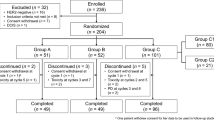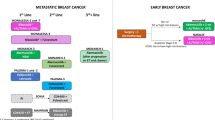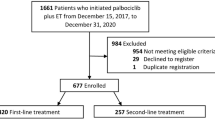Abstract
In order to explore activity and pharmacokinetic data of a docetaxel-epirubicin combination we analyzed a population of 60 metastatic breast cancer patients. All the patients had an ECOG performance status < 3; 41 patients (68%) had visceral metastases as dominant site of disease, including 33% with liver metastases. Three or more involved organs were present in 43% of patients; 35% had received prior hormonotherapy; 10% for metastatic disease. Twenty-five patients (42%) had received prior adjuvant chemotherapy; 15% a CAF regimen. Twenty per cent of patients had less than 12 months disease-free interval. Docetaxel and epirubicin were both given at a dose of 75 mg/m2 i.v. d.1 every 3 weeks. After a median of six cycles we had 5 CR (8.3%), 40 PR (66.6%), 7 NC (11.6%), and 8 PD (13.3%). Response rates in patients with visceral and liver metastases were 78% and 55% respectively. Premenopausal status, < 1 year disease free survival and > 3 metastatic sites were associated with a lower response rate. After a median follow-up of 19 months (12–36), median disease-free survival is 11 months and median overall survival has not been reached. Grade 4 neutropenia was observed in 75% of courses but with febrile neutropenia in 6.2% of courses only. Non-hematologic toxicity wasn’t clinically important. A NYHA class III reversible cardiac failure was observed in one patient (1.6%). The pharmacokinetic evaluation in 16 patients has shown that docetaxel transiently interfered with epirubicin plasma level when docetaxel was administered 1 h after epirubicin.
Similar content being viewed by others
References
Tomiak E, Piccart M, Mignolet F: Characterisation of complete responders to combination chemotherapy for advanced breast cancer: a retrospective EORTC Breast Group Study. Eur J Cancer 32: 1876-1887, 1996
A'Hern RPA, Smith IE, Ebbs SR: Chemotherapy and survival in advanced breast cancer: the inclusion of doxorubicin in Cooper type regimens. Br J Cancer 67: 801-805, 1993
Hortobagy G: Docetaxel in breast cancer and a rationale for combination chemotherapy. Oncology 6(suppl 6): 11-15, 1997
Crown J: Phase III randomized trials of docetaxel in patients with metastatic breast cancer. Sem Oncol 26(suppl 8): 33-38, 1999
Ravdin TM: Treatment of patients resistant to anthracycline therapy. Anticancer Drugs 7(suppl 2): 13-16, 1996
Launchbury AP, Habboubi N: Epirubicin and doxorubicin: a comparison of their characteristics, therapeutic activity and toxicity. Cancer Treat Rev 19: 197-228, 1993
French Epirubic in Study Group: A prospective randomized phase III trial comparing combination chemotherapy with cyclophosphamide, fluorouracil and either doxorubicin or epirubicin. J Clin Oncol 6: 679-688, 1988
Sparano JA: Doxorubicin/taxane combinations: cardiac toxicity and pharmacokinetics. Sem Oncol 3(Suppl 9): 14-19, 1999
Criteria Committee of the New York Heart Association: Nomenclature and Criteria for Diagnosis of Diseases of the Heart and Great Vessels. 8th Edn, Boston, MA, Little Brown, 1979
Villani F, Misrachi D, Galimberti M: Cardiac arrhytmia and ischaemic events after combination chemotherapy for testicular cancer. Eur Heart J 15: 1533-1536, 1994
Miller AB, Hoogstraten B, Staquet M, Winkler A: Reporting results of cancer treatment. Cancer 47: 207-214, 1991
Vergniol JC, Bruno R, Montay G, Frydman A: Determination of taxotere in human plasma by a semi-automated highperformance liquid chromatographic method. J Chromatogr 582: 273-278, 1992
Camaggi CM, Comparsi R, Strocchi E, Testoni F, Angelelli B, Pannuti F: Epirubicin and doxorubicin comparative metabolism and pharmacokinetics. Cancer Chemother Pharmacol 21: 221-228, 1988
Longo DL, Duffey PL, De Vita Jr VT, Wesley MN, Hubbard SM, Young RC: The calculation of actual or received dose intensity: a comparison of published methods. J Clin Oncol 9: 2042-2051, 1991
Fulton B, Spencer CM: Docetaxel: a review of its pharmacodynamic and pharmacokinetic properties and therapeutic efficacy in the management of metastatic breast cancer. Drugs 51: 1075-1092, 1996
Conte PF, Baldini E, Gennari A, Michelotti A, Salvadori B, Tibaldi C: Dose-finding study and pharmacokinetics of epirubic in and paclitaxel over 3-h: a regimen with high activity and low cardiotoxicity in advanced breast cancer. J Clin Oncol 15: 2510-2517, 1997
French Epirubicin Study Group: Epirubicin-based chemotherapy in metastatic breast cancer patients: role of dose-intensity and duration of treatment. J Clin Oncol 18: 3115-3124, 2000
Pagani O: Taxoids in combination with epirubicin: the search for improved outcomes in breast cancer. Sem Oncol 25(suppl 12): 23-26, 1998
Sparano JA, O'Neill A, Schaefer PL, Falkson C, Wood WC: Phase II trial of doxorubicin and docetaxel plus granulocytecolony-stimulating factor in metastatic breast cancer: an Eastern Cooperative Oncology Group study (E1196) J Clin Oncol 18: 2369-2377, 2000
Nabholtz J-M, Mackey J, Smyle M, Tonkin K: Taxane-based three-drug com bination in metastatic and adjuvant treatment of breast cancer. Sem Oncol 25(suppl 12): 27-31, 1998
Yamamoto N, Watanabe T, Katsumata N: Construction and validation of a practical prognostic index in patients with metastatic breast cancer. J Clin Oncol 16: 2401-2408, 1998
Henderson JC, Allegra JC, Woodcock T: Randomized clinical trial comparing mitoxantrone with doxorubic in in previously treated patients with metastatic breast cancer. J Clin Oncol 7: 560-571, 1989
Fumoleau P, Delgado FM, Delozier T, Monnier A, Delgado MAG, Kerbrat P, Garcia-Gitalt E, Keiling R, Namer M, Colson MT, Goudier MJ, Chollet P, Lecourt L, Montcuquet P: Phase II trial of weekly intravenous vinorelbine in first line advanced breast cancer chemotherapy. J Clin Oncol 11: 1245-1252, 1993
Alexandre J, Bleuzen P, Bonneterre J, Sutherland W, Misset JL, Guastalla J-P, Viens P, Faivre S, Chahine A, Spielman M, Bensmaine A, Marty M: Factors predicting for efficacy and safety of docetaxel in a compassionate-use cohort of 825 heavily pretreated advanced breast cancer patients. J Clin Oncol 18: 562-573, 2000
Klink-Alakl M, Riva A, Bruno R, Azli N, Lebecq A: Taxotere safety profile in patients with liver metastases with or without impaired liver function. Proc Am Soc Clin Oncol 16: 220a, (abs 770), 1997
Nabholtz JM, Smylie M, Mackey J, Au E-J, Tonkin K, Au R: Docetaxel and anthracycline polychemotherapy in the treatment of breast cancer. Sem Oncol 26(suppl 8): 47-52, 1999
Gianni L, Munzone E, Capri G: Paclitaxel by 3 h infusion in combination with bolus doxorubicin in women with untreated metastatic breast cancer: high antitumor efficacy and cardiac effects in a dose-finding and sequence-finding study. J Clin Oncol 13: 2688-2699, 1995
Gehl J, Boesgaard M, Paaske T, Jensen BV, Dombernowsky P: Combined doxorubic in and paclitaxel in advanced breast cancer: effective and cardiotoxic. Ann Oncol 7: 687-693, 1996
Gianni L, Vigano L, Locatelli A, Capri G, Giani A, Tarenzi E, Bonadonna G: Human pharmacokinetic characterization and in vitro study of the interaction between doxorubicin and paclitaxel in patients with breast cancer. J Clin Oncol 15: 1906-1915, 1997
Gottesman MM, Pastan I: Biochemistry of multidrug resistance mediated by the multidrug transporter. Annu Rev Biochem 62: 385-427, 1993
Webster L, Linsenmeyer M, Millward M, Morton C, Bishop J, Woodcock D: Measurement of Cremophor EL following taxol: plasma levels sufficient to reverse drug exclusion mediated by the multi-drug resistant phenotype. J Natl Cancer Inst 85: 1685-1690, 1993
Woodcock DM, Linsenmeyer ME, Chojnowski G, Kriegler AB, Nink V, Webster LK, Sawyer WH: Reversal of multidrug resistance by surfactants. BrJ Cancer 66: 62-68, 1992
Rowinsky EK: The development and the clinical utility of the taxane class of antimicrotubule chemotherapy agents. Annu Rev Med 48: 353-374, 1997
van Oostrerom AT, Schrijvers D: Docetaxel (taxotere), a review of preclinical and clinical experience. Part II: clinical experience. Anticancer Drugs 6: 356-368, 1995
Author information
Authors and Affiliations
Rights and permissions
About this article
Cite this article
Airoldi, M., Cattel, L., Pedani, F. et al. Clinical and pharmacokinetic data of a docetaxel-epirubicin combination in metastatic breast cancer. Breast Cancer Res Treat 70, 185–195 (2001). https://doi.org/10.1023/A:1013070612986
Issue Date:
DOI: https://doi.org/10.1023/A:1013070612986




